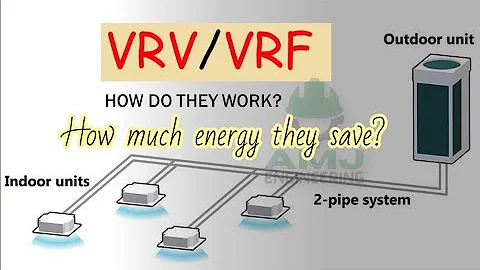
VRV stands for variable refrigerant flow system, VWV stands for variable water volume system, and VAV stands for variable air volume system. They are all a form of air conditioning system. It is easy to understand by stringing them together according to the air conditioning process.
The three processes of air conditioning refrigeration and heating include preparing cold and heat in the air conditioner host, transporting the cold and heat through the pipeline, and transferring the cold and heat to the room at the end. The cooling and heating process of the
air conditioner host is that the refrigerant circulates among the "four major parts", including two heat exchangers . One is the evaporator , in which the refrigerant absorbs heat and vaporizes, and needs to take heat from the outside, which is essentially cooling the outside; the other is the condenser , in which the refrigerant liquefies and releases heat, and needs to discharge heat to the outside. In essence, it is heating the outside. In the actual application of
, the air conditioner host uses a heat exchanger facing the user side. By changing the flow direction of the refrigerant, it is used as an evaporator in summer to take heat from the user side to cool the user; in winter, it is used as a condenser and discharges to the user side. heat, thereby providing heat to users.
If the user-side heat exchanger is placed indoors and used directly as the end to transfer heat and cold to the room, it is equivalent to using refrigerant to transport heat and cold in the pipeline. This is a "fluorine air conditioner", and this is how household split air conditioners work.
VRV can be understood in form as a "one-to-many" split air conditioner. One or more outdoor units drive the ends of multiple indoor units, and the refrigerant system directly cools and heats the room. In order to adapt to changes in indoor load, needs to continuously adjust the flow of refrigerant in the tube, which is called VRV variable refrigerant flow air conditioner.

If the user-side heat exchanger of the air conditioner host is not placed directly indoors, but first exchanges hot and cold water to the water, and then transports the cold and hot heat to the indoor end through the water, this is " water air conditioner ". In the
water air conditioner, when the indoor load changes, one is to keep the water flow constant and change the water temperature to adapt to the terminal load change. This is a fixed water volume system; the other is to keep the water temperature constant and changes the water flow through the terminal. In order to adapt to indoor load changes, the water flow in the pipeline changes at this time, which is called VWV variable flow air conditioner . The advantage is that it can save water pump power and energy consumption.
The basic form of the air conditioner end is fan coil and air conditioning box. The fan coil uses a fan to drive indoor air to exchange heat with the water coil, and transfers the heat in the water to the room on the spot. is called a "full water system". The air-conditioning box has increased power and heat exchange capacity. It is still essentially a "large fan coil", but the heat-exchanged air is sent to the destination area through the air duct. It can be understood that it ultimately transports cold and heat through the air, said It is " full air system ". In the
all-air system, when the indoor load changes, one is to keep the air volume unchanged and change the air temperature to adapt to the load change. This is the CAV constant air volume system; the other is to keep the air temperature constant and change the air volume to adapt to the load. At this time, the air volume of the air supply and return air changes, which is called VAV variable air volume air conditioner . The advantage is that it can save fan power and energy consumption.

To summarize, the VRV variable refrigerant system directly uses the refrigerant system to cool and heat the room. The refrigerant is used to transport cold and heat in the pipes, and the refrigerant flow rate is changed to adapt to load changes; the VWV variable water volume system uses water from the air conditioner host to Refrigerant heat exchange, water is used to transport hot and cold in the pipes, and the water flow is changed to adapt to load changes; VAV variable air volume system, air exchanges heat with water in the air conditioning unit, air is used to transport hot and cold in the air duct, and the variable air volume is used to adapt to load changes. Adapt to load changes. There are three types of air conditioning systems in
. VRV corresponds to the hot and cold preparation process of the air conditioner, VWV corresponds to the hot and cold transport process of the air conditioner, and VAV corresponds to the hot and cold transfer method at the end. It is easy to understand when linked together.






















